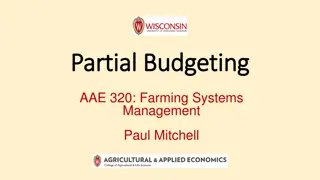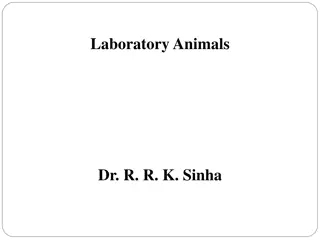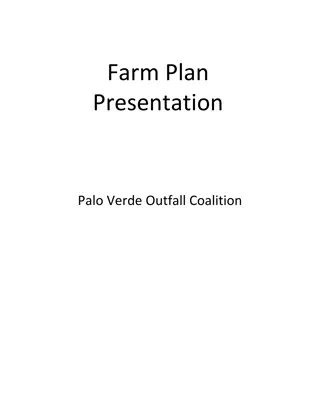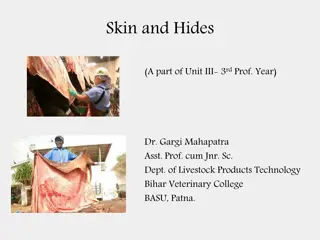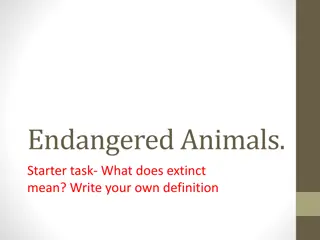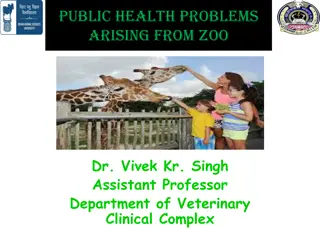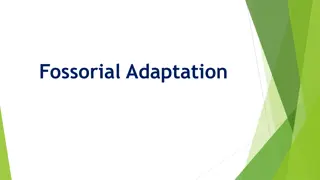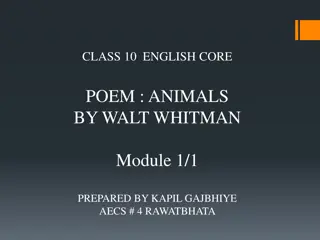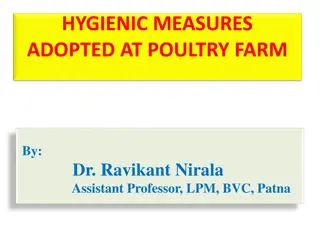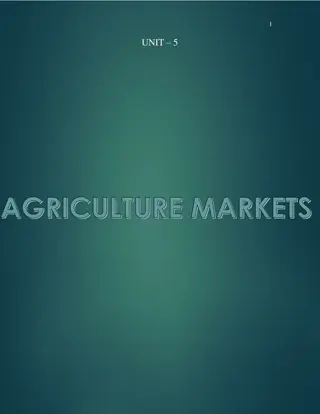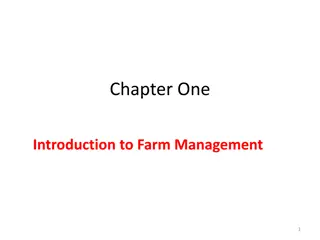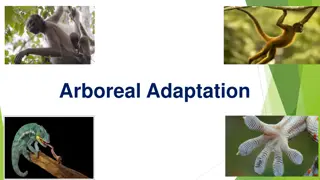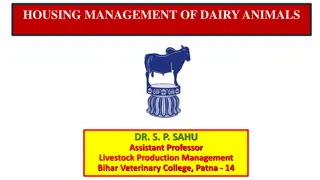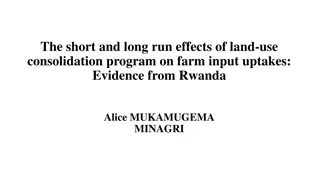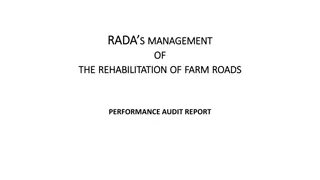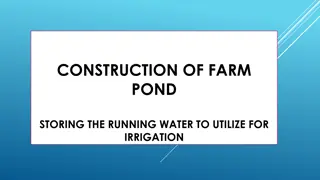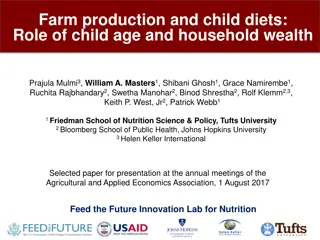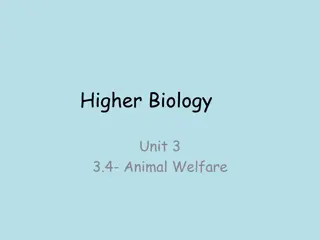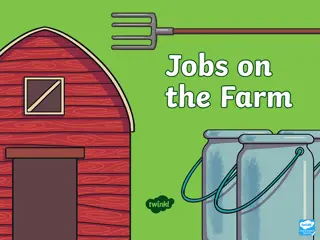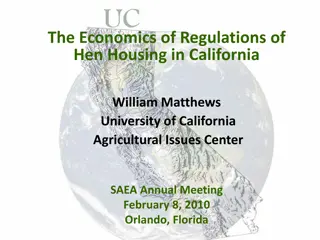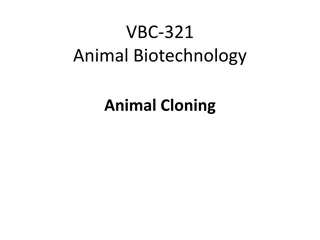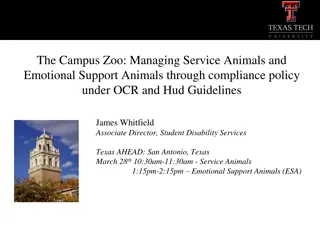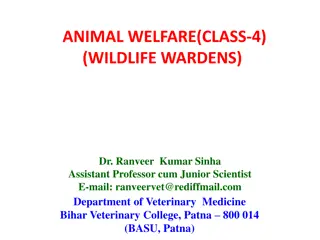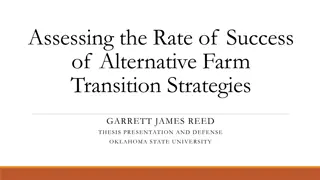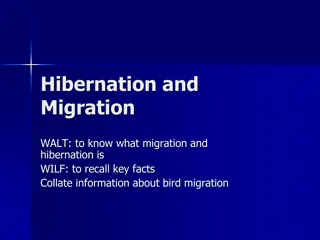Introduction to Partial Budgeting in Farm Management
Understand the purpose and methodology of partial budgets in farm management, focusing on analyzing net gains from small changes or refinements to farm operations. Learn how to build and utilize partial budgets to make informed decisions regarding farm management. Explore examples of farm management
0 views • 20 slides
Understanding constipation, scant feces, and alimentary tract hemorrhage in farm animals
Constipation in farm animals is characterized by decreased frequency of defecation and dry, hard feces. Scant feces are small quantities of feces, commonly seen in animals with stomach abnormalities. Alimentary tract hemorrhage can result from various causes, including ulcers and infestations. Hemor
0 views • 12 slides
The Prevention of Cruelty to Animals Act, 1960 Overview
The Prevention of Cruelty to Animals Act, 1960, is a legislation in India aimed at safeguarding the well-being of animals and preventing unnecessary pain or suffering. It defines important terms like animals, domestic animals, local authority, owner, and outlines the responsibilities of individuals
0 views • 16 slides
Understanding Laboratory Animals and Their Classification
Laboratory animals play a crucial role in scientific research due to their physiological similarity to humans. Common types include mice, rats, hamsters, guinea pigs, rabbits, and monkeys. They are classified into conventional and gnotobiotic animals based on their microbial status. Specific pathoge
1 views • 67 slides
Farm Plan Requirements and Best Practices Presentation for Palo Verde Outfall Coalition
Detailed information is provided in the Farm Plan Requirements and Best Practices Presentation for Palo Verde Outfall Coalition, covering essential details such as farm owner and grower information, farm location specifics, crop details, irrigation methods, chemical applications, management practice
0 views • 11 slides
Understanding the Importance of Skin and Hides in Livestock Industry
Skin and hides are crucial by-products of large and small animals, with differences in thickness and weight. They are sourced from slaughtered and fallen animals, processed through drying, tanning, and conditioning to produce leather. Leather has outstanding strength, flexibility, and weather insula
0 views • 16 slides
Common Offences Against Animals in India: Overview and Consequences
There are three common offences against animals in India: mischief, cruelty, and bestiality. Mischief involves killing, poisoning, or harming animals, punishable under IPC Sections 428 and 429. Cruelty includes acts like beating, overloading, and starvation, regulated by the Prevention of Cruelty to
0 views • 21 slides
Understanding Endangered Animals and Extinction
Explore the concept of endangered animals and extinction through tasks that involve listing endangered animals, understanding reasons for extinction, researching specific endangered species, and contemplating the ethical dilemma of keeping animals in zoos. Engage in critical thinking and research to
0 views • 8 slides
Importance of Transport System in Animals for Oxygen Supply
Animals require a transport system to meet tissue oxygen demands efficiently. The size limit for oxygen diffusion alone is around 1 mm due to the proportional increase in radius and diffusion properties. Blood is crucial for transporting oxygen, nutrients, waste products, cells, and heat, as well as
0 views • 17 slides
Understanding Public Health Risks Associated with Zoos and Wild Animals
Zoos and wildlife parks serve as hubs for public recreation and education but can also pose public health risks due to potential transmission of zoonotic diseases by veterinarians who work closely with wild animals. Approximately 61% of infectious agents affecting humans are zoonotic in nature, with
0 views • 15 slides
Understanding Fossorial Adaptation in Animals
Animals adapt to subterranean environments through anatomical and physiological modifications in a process known as fossorial adaptation. This adaptation involves creating subterranean zones through digging, leading to changes influenced by both the environment and the animals themselves. Fossorial
0 views • 17 slides
Animals by Walt Whitman: Embracing the Virtues of Animals Over Humans
Walt Whitman's poem "Animals" expresses a longing to live among animals due to their peaceful and self-controlled nature, contrasting them with the perceived greed and jealousy of humans. The poet finds solace in the virtues displayed by animals and reflects on their simplicity and contentment, high
0 views • 16 slides
Understanding Class Struggle in Animal Farm through Marxist Ideology
Animal Farm, written by George Orwell, explores the concept of class struggle through the lens of Marxist ideology. The novel depicts the conflict between the bourgeoisie, represented by characters like Mr. Jones, and the proletariat, symbolized by the other animals on the farm. Through the story of
0 views • 12 slides
Hygienic Measures for Poultry Farm Management
Poultry waste management, farm hygiene, sanitation, and environmental issues are critical for maintaining a healthy poultry farm. Disinfection, while important, is not a substitute for cleanliness. Effective disinfectants should have good germicidal activity, be non-toxic to humans and birds, work o
0 views • 18 slides
Learn Plural and Singular Forms with Animals in English
This lesson focuses on differentiating between plural and singular forms using animals as examples. Students will learn to write sentences using "They're" for plural and "It's a" for singular, while looking at pictures of various animals. By the end of the lesson, students will be confident in using
1 views • 6 slides
Understanding Agricultural Marketing: From Production to Consumption
Civilization shifted mankind from a nomadic lifestyle to farming for food production. Agriculture markets play a crucial role in distributing food from production to consumption points globally. Marketing in agriculture involves all activities related to creating utility and satisfying needs through
1 views • 38 slides
Overview of Laboratory Animals and Their Uses in Biomedical Research
Laboratory animals play a crucial role in biomedical research, serving as models for studying various conditions affecting humans and animals. They must thrive in controlled conditions and are used to test hypotheses and drugs. Commonly used lab animals include rodents, lagomorphs, canines, felines,
0 views • 9 slides
Understanding Farm Management: Key Concepts and Importance
Farm management is the strategic organization of resources and decision-making processes on a farm to ensure efficiency and profitability. This involves managing factors of production, making crucial decisions, and aiming for the prosperity of farmers and the economy as a whole. The discipline of fa
0 views • 43 slides
Understanding Arboreal Adaptation in Animals
Arboreal locomotion refers to the movement through trees exhibited by animals like squirrels, sloths, and monkeys. These animals possess physical adaptations such as long limbs, prehensile tails, and claws to aid in tree climbing. Arboreal life offers safety, retreat, and easy access to food, shapin
0 views • 14 slides
Principles of Animal Genetics and Breeding in Farm Animals
Explore the fundamentals of animal genetics and breeding with a focus on inheritance, variation, and genetic improvement in farm animals. Learn how genetics principles, population genetics, and molecular genetics play a vital role in enhancing livestock production. Discover the economic traits in ca
1 views • 16 slides
Housing Management of Dairy Animals: Objectives, Advantages, and Systems
The housing management of dairy animals is crucial to protect them from inclement weather, ensure maximum production, and safeguard against theft. Adequate housing leads to increased milk production, better health of animals, and improved reproductive efficiency. Selection of the dairy farm site is
1 views • 20 slides
Understanding Aquatic Adaptation in Animals
Aquatic adaptation refers to the changes in an animal's body organization to thrive in a water habitat. Vertebrates have evolved to lead partial or total aquatic lives, showcasing various adaptations. Water as a habitat offers a homogenous medium, stable conditions, and rich food resources. Aquatic
0 views • 9 slides
Impact of Land-Use Consolidation Program on Farm Inputs in Rwanda
The study evaluates the effects of Rwanda's land-use consolidation program on farm input uptakes, specifically focusing on hybrid seeds, inorganic fertilizers, and pesticides. Results show significant increases in the adoption of hybrid seeds and inorganic fertilizers among participating households
0 views • 10 slides
Analysis of RADA's Farm Roads Management and Rehabilitation Performance
RADA is responsible for maintaining Jamaica's farm roads island-wide. The audit assessed the effectiveness of the management system for rehabilitating farm roads and the quality management. Budget allocations for farm road rehabilitation had limitations, with a lack of transparency and accountabilit
0 views • 14 slides
Constructing Farm Ponds for Water Harvesting and Irrigation in Rural Areas
Proper water harvesting is essential for agricultural sustainability in rural areas. Farm ponds serve as reservoirs to store runoff and running water from natural sources, aiding in irrigation and fish production. The construction of a farm pond in Gram Panchayat Dulmot has significantly benefitted
0 views • 5 slides
Service and Assistance Animals Guidelines at RIT
Service and Assistance Animals Guidelines at RIT provide information on the definition of service and assistance animals, request procedures, expectations of animal and owner, and how to address concerns. The policy distinguishes between service animals trained to perform tasks for individuals with
0 views • 15 slides
Essential Considerations for Animal Housing Plan
Preparation and designing of animal houses require careful consideration to ensure attractive appearance, minimize labor costs, increase operational efficiency, and have resale value. The process involves creating a rough plan with site, floor, elevation, cross-section, master plan, Van-Dyke print,
1 views • 9 slides
Service Animals for Veterans in Georgia: A Guide to VA Guidance
Veterans in Georgia can benefit from service animals, including guide dogs and trained service animals, to assist with physical or mental impairments. The VA provides guidelines for evaluating, approving, and supporting veterans in receiving and caring for service animals. This includes information
0 views • 8 slides
Analyzing Chapter 1 of Animal Farm: Characters, Impressions, and Banned Behaviors
In Chapter 1 of Animal Farm, we are introduced to various characters such as Old Major, Mr. Jones, and different animals on the farm. Orwell uses language to portray each character's qualities and roles. The chapter focuses on Old Major's speech about revolution and equality, leading to the animals
1 views • 39 slides
Role of Farm Production in Child Diet Quality
A study explores the connection between family food production and child diet quality, focusing on the impact of child age and household wealth. Findings suggest that farm production is linked to children's intake, especially in poorer households and for older children. Dataset analysis from PoSHAN
0 views • 26 slides
Optimal Wind Farm Control Framework for Real Wind Farms
This research focuses on developing a framework for a multi-objective wind farm controller applicable to real wind farms. It addresses the significant power loss and increased fatigue loads caused by wake effects in wind farms. The objectives include composing solutions into a control framework, ide
0 views • 12 slides
Understanding Animal Welfare and Five Freedoms in Farming
Animal welfare encompasses physical and mental wellbeing, allowing animals to express natural behaviors. The Five Freedoms outline essential welfare needs, making sure animals are free from hunger, discomfort, pain, fear, and distress. The Farm Animal Welfare Council ensures these needs are met for
0 views • 16 slides
Life on the Farm: Jobs and Responsibilities of Farmers
Farmers play a crucial role in growing food and caring for animals on farms worldwide. From feeding and cleaning animals to milking cows and collecting eggs, there are various tasks involved in farm life. Farmers also look after baby animals, herd sheep, and shear wool in addition to managing crops.
0 views • 19 slides
The Economics of Regulations on Hen Housing in California
This presentation delves into the economic impact of regulations on hen housing in California, focusing on the California Treatment of Farm Animals Act and its effects on egg production. The Proposition 2 passed in 2008 mandated certain welfare standards for farm animals, including laying hens. The
0 views • 23 slides
Applications of Transgenic Animals in Biotechnology and Cloning
Cloning in animals offers the advantage of indefinite duplication of elite genotypes without the genetic risks of meiosis. Transgenic animals, genetically modified to carry foreign genes, play a crucial role in genetic research and the development of livestock with desired traits. Methods like DNA m
0 views • 13 slides
Learn Where Different Animals Live - Educational English Lesson for Class Two Students
In this engaging English lesson designed for Class Two students, they will explore where animals live through visual aids and interactive learning activities. The lesson covers various animals like birds, snakes, cows, tigers, and more, teaching students about their habitats in a fun and educational
0 views • 22 slides
Managing Service Animals and Emotional Support Animals in Compliance with ADA and HUD Guidelines
This presentation by James Whitfield explores the management of service animals and emotional support animals on campus under OCR and HUD guidelines. The session covers defining service animals, identifying them in training, recognizing emotional support animals, and understanding the distinctions b
1 views • 52 slides
Wildlife Warden Duties and Performing Animals Welfare Guidelines
Every state and union territory in India has a Wildlife Advisory Board to aid in wildlife protection, with Wildlife Wardens playing a key role in conservation efforts. They focus on preventing poaching, protecting wildlife habitats, and engaging with local communities. Additionally, guidelines are s
0 views • 8 slides
Analyzing Farm Transition Success Strategies - Thesis Presentation
Analyzing the rate of success of alternative farm transition strategies is crucial for ensuring the long-term viability and financial security of agricultural operations. This presentation delves into the importance of farm transition planning, challenges faced, reasons for failure, and the developm
0 views • 61 slides
Understanding Migration and Hibernation in Animals
Explore the fascinating behaviors of birds during migration and animals during hibernation. Discover how animals adapt to survive in changing environments, the reasons behind hibernation, dangers involved, and how different animals prepare for winter. Learn about light sleepers that are not true hib
0 views • 17 slides
